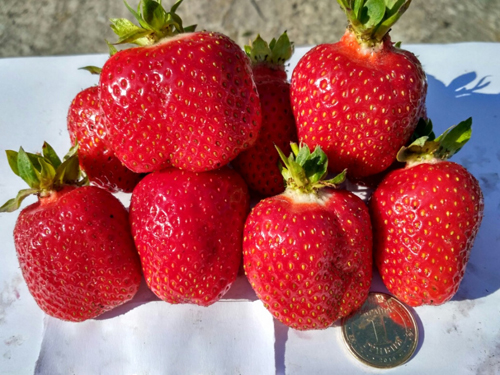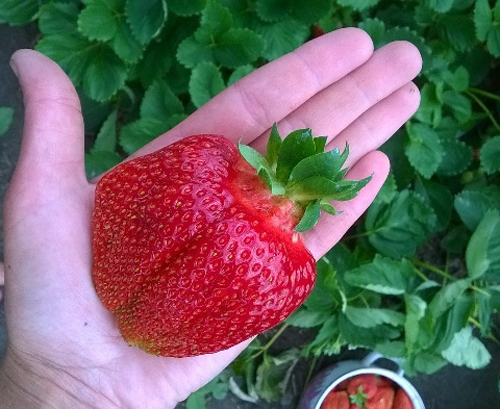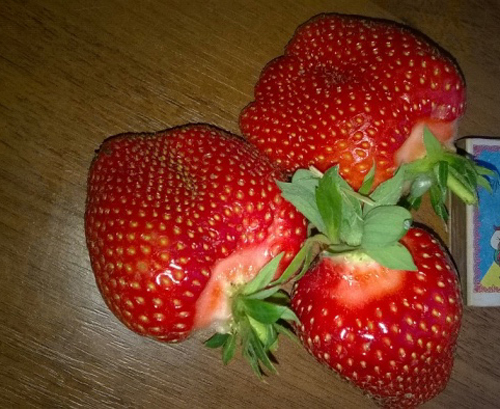Strawberry variety Asia
Asia is a mid-early non-repairable variety of garden strawberries (strawberries) for universal use. Bred in Italy, the city of Cesena, by New Fruits specialists. In 2005, the variety was officially registered and patented. Can be grown both outdoors and indoors. Very attractive for commercial cultivation in industrial areas. Strawberries are distinguished by their excellent presentation and excellent taste, thanks to which they very quickly gained popularity not only in their homeland, but also far beyond its borders.

The plant is tall, powerful, well leafy. The variety forms a mustache in medium quantities. The leaves are large, slightly wrinkled, bright green, shiny. Peduncles are long, strong, vigorous, located at or below leaf level, and are formed in large numbers, which ensures good yields.
The berries of Asia have a regular, elongated-conical shape; at the first harvest, comb-shaped fruits can be observed, however, such specimens are rare. The skin is bright red, shiny. With technical ripeness, the tip of the strawberry fruit has a white-green color; when fully ripe, the berry is completely colored red. The sepal is bright green, slightly raised. Achenes yellow, depressed to medium depth. The pulp is delicate pink in color, dense, juicy, with a pronounced multifaceted aroma. There are no voids in the berries, however, with insufficient watering, they can still form. The taste of the pulp of Asia is very sweet, truly strawberry, with a pleasant unobtrusive sourness. Many gardeners praise the taste of this variety very much, evaluating them at all 5 points!

The berries are easily separated from the stalk, after harvesting they have an excellent presentation. They are also distinguished by uniformity of shapes, which attracts buyers in the market - all berries are as if they were a selection, beautiful, shiny, and besides, large. Strawberry fruits tolerate transportation and short-term storage very well, they are especially tasty fresh, but they are also excellent for processing.
The average weight of berries in the season is 30-35 grams, in the first wave of fruiting they are much larger - 60-90 grams, and sometimes larger specimens grow. It should be noted that such "giants" often have a comb-like shape. Fruiting in Asia is quite long, but not too extended, while the berries do not shrink by the end of the season. The average yield is 1-1.2 kg per plant, but these indicators are not limiting.

This strawberry belongs to the varieties of short daylight hours, ripens with a medium early period. Fruiting begins around early June, a little later. Honey and Albs... As already mentioned, our heroine bears fruit for quite a long time - a month or more. However, in order to obtain uniform large berries, it is necessary to pay sufficient attention to the plants and provide them with the necessary nutrition. By the way, in European countries, they actively practice the cultivation of this variety in closed ground, in which it shows the best results.
Asia is highly resistant to diseases of the root system and various spots. According to the originator, it is susceptible to anthracnose, powdery mildew and chlorosis. As for winter hardiness, it should be said that the variety was bred for cultivation in mild climatic conditions with warm winters, therefore, in Russian conditions, especially in cool regions, it needs good shelter. In winters with little snow, without protection from cold weather, the risk of death of most of the plantation is very high. Spring frosts also have a very detrimental effect on plants, so it is advisable to use covering materials. By the way, under film shelters, as well as in tunnels, strawberries will not only feel more comfortable, but will also begin to bear fruit a little earlier.

In care, the variety is quite whimsical, and not on every soil it is able to justify the hopes placed on it.First, the soil must be fertile, rich in nutrient and mineral composition. On clay, sandy and carbonate soils with a low humus content, there is a high risk of chlorosis in plants, which occurs due to lack of nutrition. Strawberries are thermophilic, so you should choose a sunny place for planting. However, plants do not tolerate heat very well, so it is advisable to take care of shading. And most importantly, do not neglect watering. Asia is hygrophilous, needs stable irrigation, the best solution would be to install a drip irrigation system. If the plant does not have enough moisture, its yield will decrease, the berries will become smaller and decrease in weight due to the formation of voids inside.
The bushes are planted at a distance of 30-35 cm from each other, but the optimal distance is still 40 cm.Avoid excessive thickening of the plantings, this will lead to a decrease in plant productivity, and also increase the risk of diseases. By the way, it is extremely important to timely comply with all preventive measures for diseases to which our heroine is weakly resistant. Another point that you should pay great attention to is regular feeding. Strawberries are large-fruited and high-yielding, therefore they require appropriate nutrition. However, it should be said that she does not need excessive "feeding". Three times fertilization will be enough. Organics are used even before planting and before the flowering of plants, then they give preference to mineral fertilizing. Asia forms a fairly small number of mustaches, and rationing their number will not cause much trouble, which makes our heroine attractive for growing on a large scale.
In conclusion, let's summarize. The variety has gained great popularity in a short period of time, having proven itself very well both in personal plots and in industrial areas. It really lives up to its name "commercial", having an excellent presentation of berries and high yields. And in terms of taste, it surpasses many other popular varieties that are firmly established in the market.
But still, Asia has rather big drawbacks. Firstly, plants are demanding on soil fertility and are very whimsical to care for. Secondly, they have low resistance to some common diseases, which means they require additional time and money for preventive treatments. Thirdly, strawberries need good nutrition and regular watering, they will not tolerate neglect of themselves - they will reduce the yield. Fourthly, the variety is poorly adapted to difficult climatic conditions, and in the northern regions of Russia will require much more attention to itself. On the other hand, indoors, the last point will not cause problems.
In a word, Asia is certainly a very good strawberry that can please you with a large harvest and excellent taste. But to get a good result, you will have to make enough effort. Reviews of gardeners about our heroine are only positive - despite all her whims, she really has excellent taste, which is the main indicator for a simple amateur gardener. Concerning yields, opinions differ. Someone is satisfied with it, someone - a little. It is worth saying that in numbers the variety is not much inferior to other varieties, but how realistic and achievable these figures are and whether they are worth the labor expended at all is another question that deserves a separate article.









There are a lot of rave reviews about garden strawberries Asia. And this is no coincidence, because this berry really delights. The taste of this wonderful variety will delight even the most fastidious strawberry gourmets. The pulp just melts in your mouth, the taste is sweet, honey. Whoever tried it with me, no one remained indifferent.
The berries are very large, conical in shape, but quite often, especially at the first fruiting, I have specimens of a comb-shaped shape. Ideal for freezing.
To avoid such diseases as powdery mildew, fungal gray rot, to which the Asia variety is quite often susceptible, I carry out regular spraying with biofungicides, and also apply a variety of dressings.
Although the variety is of overseas origin, it has successfully adapted to the unpredictable Siberian climate. From year to year it pleases and delights with its harvests. Suitable for both hobby gardening and intensive industrial cultivation.